Imagine loving dogs but petting them causes your face and hands to swell up and your throat to tighten. That’s what happens to people who are allergic to dogs.
The allergies are caused by the dander found in a dog’s fur. Some dogs don’t shed much or at all and are perfect options for people with severe allergic reactions to dog dander.
Hi, my name is Jennifer and I have two dogs – a Weimaraner named Ruger and a Yorkie named Lola. Luckily, I am not allergic to dogs because Ruger sheds A LOT.
Lola is a non-shedding small dog, but that wasn’t the reason I adopted her. (I just love Yorkies.)
My first awareness of hypoallergenic dogs was when Bo Obama became the First Dog of the U.S. in 2009. Bo is a medium-sized Portuguese Water Dog. A hypoallergenic dog was a necessity due to First Daughter Malia Obama’s allergies.
Are Non-shedding and Hypoallergenic the Same Thing?
Growing up on a farm, I’ve never paid much mind to whether a dog sheds or not. Brushing dog hair off my clothing comes as a second-nature to me, particularly with a Weimaraner.
While the terms “non-shedding” and “hypoallergenic” are often used interchangeably, they aren’t exactly the same thing. Non-shedding dogs are dogs that shed very little or, in the case of hairless dogs, not at all.
Many non-shedding dogs are considered hypoallergenic simply because the dander that causes most dog allergies are found in the dog’s fur.
The reasoning for calling non-shedding dogs hypoallergenic is that if it doesn’t shed, it can’t cause allergies.
But that’s not entirely true. There is much debate in the dog world whether any dog can be truly hypoallergenic. While the dander is the biggest culprit in allergies, some people are allergic to dog saliva.
Why Choose Non-Shedding Dogs
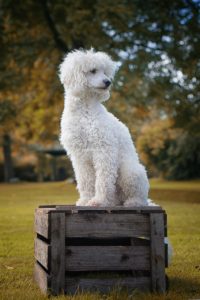
The main reason people look for non-shedding dogs is that they believe these types of dogs are hypoallergenic and won’t cause an allergic reaction.
Interestingly, you can be allergic to one type of hypoallergenic dog but not another. This is most likely due to the source of your allergies being saliva and not dander.
Allergies might be the most popular reason people go for non-shedding dogs, but it’s not the only reason.
Some people prefer to have a dog that sheds little-to-none simply because they don’t want dog hair all over their homes, furniture and clothing. These are probably the same people who don’t let their dogs sleep in the bed.
Dogs with longer hair or fuller coat require more grooming and maintenance than dogs that don’t shed. Some people might not be able to afford the necessary grooming upkeep for dogs that shed.
Non-shedding doesn’t necessarily mean less grooming, though. Lola is Yorkie, one of the top non-shedding dogs, and requires professional grooming every six weeks.
Ruger, on the other hand, has never been to a professional groomer and he sheds a lot for having short, coarse hair.
Can’t I Just Shave My Dog’s Fur?
Whether you’re considering shaving your dog as a solution to shedding or allergies, the answer is NO! Shaving your dog won’t solve either problem and can be very harmful to your dog.
If you’re allergic to a dog’s dander, shaving the dog won’t make the allergy go away because the dander is also found on the flakes of the dog’s skin. When a dog shakes its coat, the dander releases into the air, causing allergic reactions.
Even if your dog is shaved, it will still continue to shed unless it is a dog that sheds very little to begin with. Shaving a dog can bring a myriad of skin problems, most notably sunburn.
Whether you’re looking for non-shedding dogs for allergy-related reasons or other reasons, here are 10 small non-shedding dog breeds for you to consider:
10 Small Non-Shedding Breeds to Consider
1) Maltese
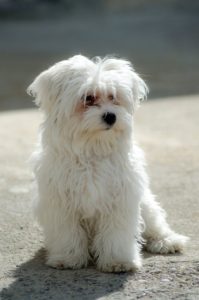 The history of the Maltese goes back so far in ancient times that famed philosopher Aristotle mentioned Maltese dogs in his writings in 370 BC.
The history of the Maltese goes back so far in ancient times that famed philosopher Aristotle mentioned Maltese dogs in his writings in 370 BC.
Originally thought as bred to hunt vermin, Maltese quickly became a laptop of royalty. “Roman Ladies’ Dog” is one of its many nicknames.
Maltese were almost wiped out in the 17th and 18th centuries by breeders attempting to make the breed smaller in size than it already was.
In order to keep the breed in existence, Maltese were cross-bred with other breeds, such as poodles and other terriers.
The temperament of the Maltese breed is that of a lively and playful dog, even when they reach old-age. Maltese dogs don’t shed, which makes them a popular choice for people looking for hypoallergenic dogs.
Maltese are fine around older children but may react snappishly around younger children who don’t yet understand how to be gentle with small dogs.
2) Yorkshire Terrier (Yorkie)
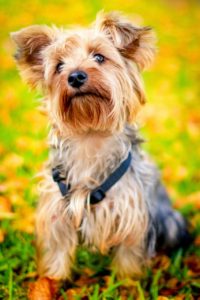 Yorkies were created when migrants from Scotland crossed various terrier breeds, such as Scottish, Clydesdale and Skye terriers to make a breed small enough to hunt rats in mines.
Yorkies were created when migrants from Scotland crossed various terrier breeds, such as Scottish, Clydesdale and Skye terriers to make a breed small enough to hunt rats in mines.
That was the humble beginning of the regal Yorkie. Yorkies later caught the eyes of royal ladies, who made them into the lapdogs that they are today.
Their rat-hunting days behind them, Yorkies still have the confidence and drive of their ancestors, which is often displayed in their “small dog syndrome,” where they think they are bigger than the biggest of dogs.
This confidence can sometimes get them in trouble, but my Yorkie, Lola, is lucky because my Weimaraner (who is easily 3 times her size) is easy-going and lets her steal his toys and generally boss him around.
Yorkies are known for their feistiness, but they are also playful and affectionate. Their fur can grow long if preferred or can be cut short. While they are a non-shedding dog, they still require daily grooming to keep their fur from matting.
3) Shih Tzu
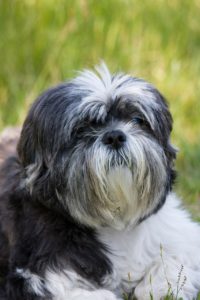 Their name literally means “lion dog” in Chinese. More like lion cub! Considered one of the oldest dog breeds in the world.
Their name literally means “lion dog” in Chinese. More like lion cub! Considered one of the oldest dog breeds in the world.
Some documents show that the Shih Tzu were given to the Chinese royal court from the Byzantine Empire.
They were house pets as far back as the Ming Dynasty (1368 – 1644 AD.)
Unlike the humble beginnings of the Yorkies and Maltese, Shih Tzu’s have always been owned by people with royal lineage or wealth.
Shih Tzu’s are easily trained and adorable to look at with their little button noses, which makes them a constant on the dog show circuit.
Their temperament is affectionate, loyal and alert. While they are quite playful, a Shih Tzu makes an unintentional watchdog with its highly alert nature. Of course, an intruder is more likely to die from cuteness overload or being mauled… with kisses!
Shit Tzus are another non-shedding dog that requires daily grooming.
4) Affenpinscher
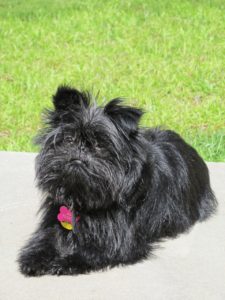 A German Breed, the word “Affa” in their breed name means “monkey” in German. Quite a fitting name if you’ve seen an Affenpinscher’s face.
A German Breed, the word “Affa” in their breed name means “monkey” in German. Quite a fitting name if you’ve seen an Affenpinscher’s face.
The breed has come a long way from its origins of hunting rats in kitchen and stables. An Affenpinscher won the Westminster Dog Show in 2013.
The face of the Affenpinscher makes everything they do seem funny and their owners are constantly entertained by their playful antics. The breed is known for its stubbornness, which can make the dogs difficult to train.
Other than that, they are an affectionate breed who crave activity and can become bored quite easily.
The coat of an Affenpinscher is described as “short, but shaggy.” They are considered non-shedding dogs and don’t need as much grooming as the other small dogs. A combing every 2 weeks should suffice.
5) Basenji
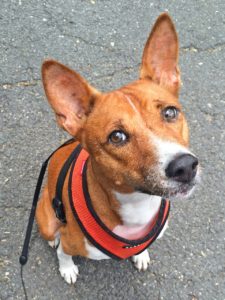 The Basenji breed began as a hunting dog in Africa. Dogs of their likeness is shown in paintings dating back to the Twelfth Dynasty of Egypt.
The Basenji breed began as a hunting dog in Africa. Dogs of their likeness is shown in paintings dating back to the Twelfth Dynasty of Egypt.
They are classed in the sighthound group for their ability to track and trap prey. Basenjis aren’t a well-known breed in the US, ranking low on the list of most popular dog breeds to own.
Despite their status on the subjective “popular breeds” list, Basenjis are an asset to any home. They are often referred to as the “non-barking dog” due to their unique vocalizations that are more of a yodel than a bark.
Alert and curious, this breed requires a lot of exercise and playtime. They love to play and are known for their relentlessness that will get their owner to play with them.
They are a very intelligent breed that has retained the craftiness of their hunting ancestors.
Basenjis have short coats that shed very little. As a result, they only require a minimum amount of grooming.
6) Brussels Griffon
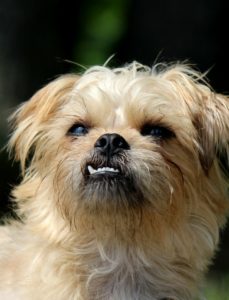 As their name suggests, Brussels Griffons originated in Brussels, Belgium. Bred from a cross of Pugs, King Charles Spaniels and wry-coated stable dogs, there is some history of hunting rodents in stables in the ancestry of the breed.
As their name suggests, Brussels Griffons originated in Brussels, Belgium. Bred from a cross of Pugs, King Charles Spaniels and wry-coated stable dogs, there is some history of hunting rodents in stables in the ancestry of the breed.
The Brussels Griffon rose in popularity in Europe when the Queen of the Belgians, Queen Marie Henriette spotted them at a Belgium dog show and began to breed them.
However, an attempt to breed out such imperfections as webbed feet by breeders during the time frame between the First and Second World Wars almost wiped the breed out entirely.
Brussels Griffon are known to be people dogs and bond with just one person above all other people. They are considered great watchdogs due to their inquisitive nature. Their coats don’t shed much at all.
Fun fact: Ewoks were created based on the Brussels Griffon Star Wars director George Lucas owned at the time.
7) Hairless Chinese Crested
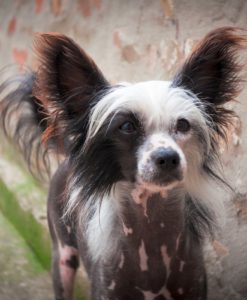 Surprisingly, the origins of the Chinese Crested dog are believed to be in Africa, not China, as their name suggests.
Surprisingly, the origins of the Chinese Crested dog are believed to be in Africa, not China, as their name suggests.
The breed name is considered likely due to their history as rat hunters (ratters) on Chinese ships.
There are actually two types of Chinese Crested – those with hair and those without.
The ones with hair are called Powderpuff. The Hairless Chinese Crested Dog does have some hair on its head, feet and tail. Both versions of the breed are considered non-shedding dogs.
8) Toy Poodles
 While the history of the Standard Poodle is still under debate, Toy Poodles were bred in England in the 18th century.
While the history of the Standard Poodle is still under debate, Toy Poodles were bred in England in the 18th century.
The Standard Poodle was used in hunting, but the Toy Poodles were and are considered mostly as companion pets.
Poodles are highly regarded as one of the most intelligent dog breeds. They are very sociable animals and thus, do not like to be left alone for long periods of time.
They require a lot of exercise to satisfy both their intelligence and their high level of playfulness.
Poodles have a lot of fur, so it might be surprising that they are considered non-shedding hypoallergenic dogs.
However, the curls in their coats traps the dander and the constant grooming also lowers the amount of shedding.
9) Scottish Terrier (Scottie)
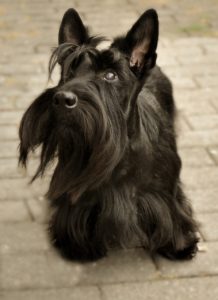 Yes, another terrier on the list! Originating in Scotland, Scottish Terriers (known as Scotties) were bred to hunt badgers and other vermin in the Scottish Highlands. Despite their meager beginnings,
Yes, another terrier on the list! Originating in Scotland, Scottish Terriers (known as Scotties) were bred to hunt badgers and other vermin in the Scottish Highlands. Despite their meager beginnings,
Scotties were later owned by not one, but two US Presidents – George Washington and Franklin Delano Roosevelt (FDR.) In fact, FDR’s Scottie Fala is included in this statue in Washington, D.C.
Unlike other terrier breeds, Scottie’s are quite active and prefer outdoors activities to lounging on laps in the house. While they are considered an independent breed, they shouldn’t be left alone in your yard because they like to dig and are also quite mischievous.
Scotties are feisty dogs who often forget their size in relation to bigger dogs, which is a common trait among other small terrier breeds. They are considered aloof because they are apprehensive around strangers but love their family.
Even with their non-shedding fur, Scotties still need to be brushed regularly, as well as taken to a professional groomer several times a year.
10) Xoloitzcuintli
No I haven’t just swiped my hand across the keyboard… Xo-what? Commonly shorted to just “Xolo,” Xoloitzcuintli is pronounced as “sho-lo-itz-queent-lee” and is often referred to as the Mexican Hairless Dog.
The origins of Xolos can be traced to the ancient Mayans and Aztecs. The tombs of these old civilizations often hold archeological evidence of these dogs.
Believed to hold magic powers by the Aztecs, the name of the breed is a combination of the Aztec word for dog (Itzcuintli) and the Aztec god of the underworld (Xolotl.) The lifespan of the Xolo can be up to 20 years, which is far greater than most dog breeds.
Known as calm dogs, Xolos are sensitive and gentle dogs who follow their owners around at all times. (To be fair – what dog doesn’t?)
Their high level of intelligence means a significant amount of exercise is needed to keep them healthy and on their best behavior. They are not a breed to be left alone in yards unattended because they are escape artists.
Obviously, they don’t shed because they are hairless. I’m sure you’re googling them right now!
Final Thoughts
While some people base their choice of dog breed on how active the dogs are or how cute they are, others have to seriously consider whether a dog will send them into the fits of an allergic reaction.
If you need help training any of these beautiful non shedding small dogs check out this article here!
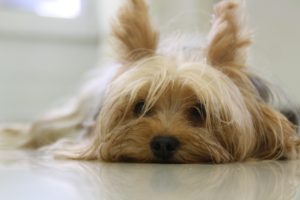 Also you may not want to constantly clean-up after a dog who sheds enough that you can build a second dog!
Also you may not want to constantly clean-up after a dog who sheds enough that you can build a second dog!
Dogs are the absolute best. I hope this list of non-shedding dogs is helpful in finding your new best friend.
If you have any questions or comments, please leave them below!

